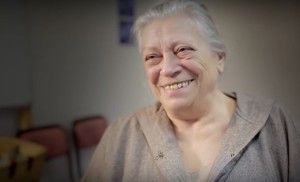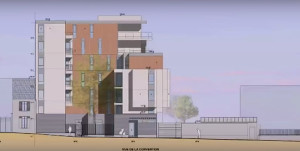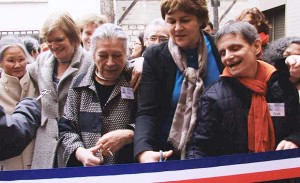FROM: SENIOR PLANET- AGING WITH ATTITUDE – MARCH 2016
SENIOR HOUSING ALTERNATIVES:
URBAN COHOUSING THE BABAYAGA WAY
BY LINDA ABBIT 03/06/2016
Aging in place:
It’s what 90 percent of seniors say they want for themselves, according to AARP. But even after we’ve retrofitted our homes, do we really want robot “companions” and sensor-powered systems that inform friends or family when we haven’t opened the refrigerator for two days? Isolation might not be a good trade-off for independence – apart from anything else, research shows clearly that it can kill us. What’s the option if you’re not the retirement community type or can’t afford longterm care? This is the first in a series of articles exploring innovative alternatives to aging in place.
“I’m 84, but what time I have left is going to be happy and fulfilled, I’m sure of that. Old age isn’t about being shipwrecked. It isn’t an illness. It can be beautiful ,and I plan to live it that way, with my friends and colleagues here.” Babayaga founder Thérèse Clerc in an RFI radio interview
Thérèse Clerc was in her mid-60s when she started to think about how women could grow into old age without losing autonomy. An energetic, passionate feminist living in Paris, she knew that her generation of French women had not been able to build up retirement funds to cover at-home care, because they had spent years caring for families.
Older women in France, as elsewhere, are among the poorest segment of the population. And Clerc didn’t like what she saw when she visited state-run homes, where life was dull and regimented. Clerc knew that living by someone else’s rules, or, on their schedule was not in her future. A lifelong activist, she also was interested in demonstrating that old age can be a beautiful time of life.
Thérèse Clerc
So Clerc got together with some activist friends and came up with the idea to create an exclusively female, self-governing, environmentally friendly cohousing collective for women who want to live independently into old age — yet within a supportive and fully engaged community. They would call it the Babayagas’ House after a supernatural being in Slavic folkore — a witch who offers guidance to younger women.
Other groups have followed suit in France and Canada, developing their own models based on the Parisians’, but with some key differences.
The Original Baba Yaga House: From Idea to Reality
The Babayagas’ House, Rendering
A brand new apartment building, Babayagas’ House opened in the Paris suburb of Montreuil, France in October 2012, 13 years after the women first hatched their plan. Many of those years were spent securing government funding for the project.
The Babayagas’ pitch: The government would save money in the long run by investing in the construction, since the residents would not have to rely on state-run homes down the road.
Nor would the government have to staff the Babayagas’ House with care workers. Eventually, the government agreed: Eight state agencies contributed to the four million Euros required to build the Babayagas’ House.
As of late last year, the Babayagas’ six-story apartment building accommodated 21 women ages 66 through 89. Seven of the 21 residents are living on the poverty line.
Most residents occupy small one-bedroom apartments; some share with roommates. Together, they live, eat and care for one another in the housing project, with no cooks, nurses or other professional staff.
Each woman agrees to perform 10 hours of chores per week. The residents plan to pool resources for a doctor or nurse to visit monthly, and one small room that’s currently set aside for guests could serve as accommodation for medical staff if needed.
Integrating with the Outside Community
The Babayaga model is an urban one. In Paris, the house is close to shops and the metro. Being centrally located is important for the women’s ease in coming and going, and for encouraging the greater community to come in and participate in what the Babayagas have to offer — and their offerings are significant.
A key feature of the Babayaga model is its 860 square ft. ground floor space that’s dedicated as an open university that anyone from the surrounding community can attend. In this intergenerational center, the Babayagas run courses, offer discussion groups, do creative writing and give concerts.
One of the tenets of the Babayaga model is that the residents will be actively engaged with the world politically, socially and culturally.
“Staying intelligent will keep us healthy…. I believe women who are happy, not bored, will live healthier lives,” Clerc says.
[Editor’s note: Thérèse Clerc died of cancer in February, 2016, while we were working on this article.]
The Babayaga Model Expands to the Americas
With Clerc’s guidance, other groups of seniors have started Babayaga projects in French cities, and after Canada’s CBC radio broadcast a couple of programs in 2013 about the original Babayagas’ House, seniors across Canada, enthralled, started to think about creating their own version.
In Toronto, the interest list for Baba Yaga Place has attracted more than 150 members, and the group is applying for a feasibility study to be funded in part, by the Canadian government.
Baba Yaga Place has set 50 as the minimum age for residents, and accessibility for people with restricted mobility is high on the women’s list.
So is an intergenerational focus. Like their Parisian counterparts, the Toronto Baba Yagas see intergenerational exchange as a core part of their model: ” We have lots to offer to our working neighbors, who may benefit from an experienced cook, dog walker, someone to sign for their parcels, or a babysitter,” Iris Kairow, a 60-year-old and one of the founding members of Toronto’s Baba Yaga Place, told Senior Planet by email.
“The socio-political aspect of Baba Yaga means we stay active and involved in the broader community, not isolated,” Kairow notes.
Baba Yaga Place: The Canadian Version
Unlike the Babayagas’ House, Toronto’s residence will be open to all genders — “But,” Kairow says, “the majority of elderly who seek out Baba Yaga will continue to be women.”
How will idea become reality in Toronto? For reasons of budget and expedience, the group is considering populating an existing apartment building, which would be run as a nonprofit coop, rather than building a new one. Several multipurpose common spaces would be created and each member would participate in decision-making, as well as sharing tasks.
” We have learned that the government policy promoting Aging in Place can lead to isolation and mental health deterioration. It’s also expensive for funding the safety modifications that make individual homes accessible as mobility declines with age, and for funding the nursing care to each person’s home.”
With isolation increasingly pegged as a contributor to ill health in old age, Kairow makes a strong case for funding. “The savings to our society will be evident by avoiding mental health issues, by staying independent and active, and by postponing entry into nursing home care — all expected to be significant cost savings.”
The Babayagas
cut the ribbon
What happens when residents need care? Residents would care for one another, and the Baba Yaga community would make sure to provide additional care when needed.
Currently, Kairow sees nursing care as being secured and paid for by individual members; it would be interesting to see the communal model expand, so that as the community ages and more members need specialized care, they could hire providers as a group and dedicate living space in the house for them.
Baba Yaga Place is still in the germinal phase, but the community that’s developed around the project has already paid dividends: “We have each come together as strangers and met some wonderful new friends,” Kairow says. “Our leader is 78 years old and rides her bike to work every day in Toronto!”
The Nitty Gritty
What does it take to create and live in a community based on the Babayaga model? We took a look at the Babayagas’ House in Paris.
Cost of Housing: Moderate
The French government subsidized the construction, and residents pay an average of 420 euros or $460 for a 375-square-foot apartment.
Health Services: Communal and flexible
Monthly visits by a healthcare professional are paid for communally, and the group has a plan and accommodation in place in case live-in care is needed.
Transportation and community services: Easy access
The Babayagas purposefully built their house near public transportation and everyday resources like shops, which makes it easier for residents to stay independent and active.
Commitment factor: High
From community-building to funding and setting up self-governing structures, making a Babayaga-style cohousing project happen takes extraordinary amounts of time and energy. But if the pioneers do a good job of documenting the benefits and savings, and the model spreads, there’s a good chance that local governments elsewhere may start to support similar projects.
More Information
• Listen to a story in English about the Babayagas on the French radio station RPT
• Visit the Babayagas’ website (if you’re using the Chrome browser, click on Translate at the top of your screen for English)
•
• Visit the website for Baba Yaga Place
Babayaga is a creative alternative for people who want to live independently, have the camaraderie and support of housemates, make their own rules and engage with the local community. It’s not for everyone.
FROM: SENIOR PLANET- AGING WITH ATTITUDE SENIOR HOUSING ALTERNATIVES: URBAN COHOUSING THE BABAYAGA WAY – 03/06/2016 BY LINDA ABBIT
HTTP://SENIORPLANET.ORG/SENIOR-HOUSING-ALTERNATIVES-URBAN-COHOUSING-THE-BABAYAGA-WAY/









